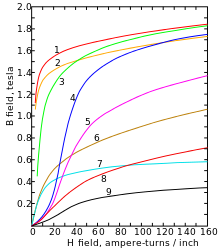Saturation (magnetic)

Seen in somemagneticmaterials,saturationis the state reached when an increase in applied externalmagnetic fieldHcannot increase themagnetizationof the material further, so the total magnetic flux densityBmore or less levels off. (Though, magnetization continues to increase very slowly with the field due toparamagnetism.) Saturation is a characteristic offerromagneticandferrimagneticmaterials, such asiron,nickel,cobaltand their alloys. Different ferromagnetic materials have different saturation levels.
Description[edit]
Saturation is most clearly seen in themagnetization curve(also calledBHcurve orhysteresiscurve) of a substance, as a bending to the right of the curve (see graph at right). As theHfield increases, theBfield approaches a maximum valueasymptotically,the saturation level for the substance. Technically, above saturation, theBfield continues increasing, but at theparamagneticrate, which is severalorders of magnitudesmaller than the ferromagnetic rate seen below saturation.[2]
The relation between the magnetizing fieldHand themagnetic fieldBcan also be expressed as the magneticpermeability:or therelative permeability,whereis thevacuum permeability.The permeability of ferromagnetic materials is not constant, but depends onH.In saturable materials the relative permeability increases withHto a maximum, then as it approaches saturation inverts and decreases toward one.[2][3]
Different materials have different saturation levels. For example, high permeability iron alloys used in transformers reach magnetic saturation at 1.6–2.2teslas(T),[4]whereasferritessaturate at 0.2–0.5T.[5]Someamorphousalloys saturate at 1.2–1.3T.[6]Mu-metalsaturates at around 0.8T.[7][8]

Explanation[edit]
Ferromagnetic materials (like iron) are composed of microscopic regions calledmagnetic domains,that act like tinypermanent magnetsthat can change their direction of magnetization. Before an external magnetic field is applied to the material, the domains'magnetic fieldsare oriented in random directions, effectively cancelling each other out, so the net external magnetic field is negligibly small. When an external magnetizing fieldHis applied to the material, it penetrates the material and aligns the domains, causing their tiny magnetic fields to turn and align parallel to the external field, adding together to create a large magnetic fieldBwhich extends out from the material. This is calledmagnetization.The stronger the external magnetic fieldH,the more the domains align, yielding a higher magnetic flux densityB.Eventually, at a certain external magnetic field, thedomain wallshave moved as far as they can, and the domains are as aligned as the crystal structure allows them to be, so there is negligible change in the domain structure on increasing the external magnetic field above this. The magnetization remains nearly constant, and is said to have saturated.[9]The domain structure at saturation depends on the temperature.[9]
Effects and uses[edit]
Saturation puts a practical limit on the maximum magnetic fields achievable in ferromagnetic-coreelectromagnetsandtransformersof around 2 T, which puts a limit on the minimum size of their cores. This is one reason why high power motors, generators, andutilitytransformers are physically large; to conduct the large amounts ofmagnetic fluxnecessary for high power production, they must have large magnetic cores. In applications in which the weight of magnetic cores must be kept to a minimum, such as transformers and electric motors in aircraft, a high saturation alloy such asPermenduris often used.
Inelectronic circuits,transformers andinductorswith ferromagnetic cores operatenonlinearlywhen the current through them is large enough to drive their core materials into saturation. This means that theirinductanceand other properties vary with changes in drive current. Inlinear circuitsthis is usually considered an unwanted departure from ideal behavior. WhenACsignalsare applied, this nonlinearity can cause the generation ofharmonicsandintermodulationdistortion. To prevent this, the level of signals applied to iron core inductors must be limited so they don't saturate. To lower its effects, an air gap is created in some kinds of transformer cores.[10]Thesaturation current,the current through the winding required to saturate the magnetic core, is given by manufacturers in the specifications for many inductors and transformers.
On the other hand, saturation is exploited in some electronic devices. Saturation is employed to limit current insaturable-core transformers,used inarc welding,and ferroresonant transformers which serve asvoltage regulators.When the primary current exceeds a certain value, the core is pushed into its saturation region, limiting further increases in secondary current. In a more sophisticated application,saturable core inductorsandmagnetic amplifiersuse a DC current through a separate winding to control an inductor'simpedance.Varying the current in the control winding moves the operating point up and down on the saturation curve, controlling the alternating current through the inductor. These are used in variablefluorescent lightballasts,and power control systems.[11]
Saturation is also exploited influxgate magnetometersandfluxgate compasses.
In some audio applications, saturable transformers or inductors are deliberately used to introduce distortion into an audio signal. Magnetic saturation generates odd-order harmonics, typically introducing third and fifthharmonicdistortion to the lower and mid frequency range.[12]
See also[edit]
References[edit]
- ^Steinmetz, Charles (1917). "fig. 42".Theory and Calculation of Electric Circuits.McGraw-Hill.
- ^abBozorth, Richard M. (1993) [Reissue of 1951 publication].Ferromagnetism.AN IEEE Press Classic Reissue.Wiley-IEEE Press.ISBN0-7803-1032-2.
- ^Bakshi, V.U.; U.A.Bakshi (2009).Basic Electrical Engineering.Technical Publications. pp. 3–31.ISBN978-81-8431-334-5.
- ^Laughton, M. A.; Warne, D. F., eds. (2003). "8".Electrical Engineer's Reference Book(Sixteenth ed.). Newnes.ISBN0-7506-4637-3.
- ^Chikazumi, Sōshin (1997). "table 9.2".Physics of Ferromagnetism.Clarendon Press.ISBN0-19-851776-9.
- ^USA 5126907,Yoshihiro Hamakawa, Hisashi Takano, Naoki Koyama, Eijin Moriwaki, Shinobu Sasaki, Kazuo Shiiki, "Thin film magnetic head having at least one magnetic core member made at least partly of a material having a high saturation magnetic flux density", issued 1992
- ^"Shielding Materials".K+J Magnetics.Retrieved2013-05-07.
- ^"Mumetal is one of a family of three Nickel-Iron alloys".mumetal.co.uk. Archived fromthe originalon 2013-05-07.Retrieved2013-05-07.
- ^ab"Magnetic properties of materials"(PDF).unlcms.unl.edu.Retrieved2016-03-16.
- ^Rod, Elliott (May 2010)."Transformers - The Basics (Section 2)".Beginner's Guide to Transformers.Elliott Sound Products. Archived fromthe originalon 2019-07-21.Retrieved2011-03-17.
- ^Choudhury, D. Roy (2005). "2.9.1".Modern Control Engineering.Prentice-Hall of India.ISBN81-203-2196-0.
- ^"The Benefits of Harmonic Distortion (HMX)".Audient Help Desk.Retrieved2020-07-16.



